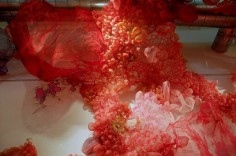LISA KELLNER
source: highlike
Work: Surfacing Beneath
2010 – 2009
Silk, pigment, paint, thread, bleach, embroidered text, wall drawing and painting, monofilament, tacks.
12′ x 8′ x 45′
Installed at the Brooklyn Arts Council, Brooklyn, NY. This piece grew over a period of 6 months.
This image reflects a site responsive installation made primarily from hand forming and painting silk.
Rooted in the language of decay, erosion and disease, my Site Responsive installations merge intricate microcosms with immense topographies. These works use the imagery of diseased cellular activity to directly respond to the space in which they are installed. The natural elements of water, air and sun (heat) are my means of achieving form. I hand form, paint and sew together thousands of organic shapes out of silk organza creating a structure that operates both as environmental sculpture and a three dimensional painting in space.
Silk performs similar to a layer of epidermis. It is translucent, yet deceptively strong. Silk maintains the shape of organ-like structures while operating symbolically as a facade. Because the original objects are removed, light and shadow are able to penetrate through the sculptured shell of silk. These works are not dyed. Rather, they go through a lengthy process in which raw pigment, ink, acrylic, bleach and compost are applied until the intended painterly effect is achieved. Merging solid and ethereal constructions allows for notions of place and landscape in a rapidly shifting environment to be explored.
At the conclusion of an installation, the materials are brought back to a raw state and incorporated into the next project. The silk acquires added patina that informs the forthcoming piece. The only remaining artifact of the installation are the photographs I take.
Photographer: Lisa Kellner
.
.
.
.
.
.
.
source: beautifuldecay
It’s difficult to discern whether Lisa Kellner‘s silk installations are natural or intrusive, peaceful or menacing. Her delicate fabric structures resemble jellyfish or coral as much as something cancerous or viral. Kellner’s work intentionally inhabits this duality. Each installation is made out of silk – a medium that is at once organic but also extremely strong. Her sculptures illustrate the curious path of growth organic matter can take. Lisa Kellner says of her artwork:
“The quickest path from point a to point b is a straight line. But nature is filled with curves and crevices. And human nature always seems to prefer a more circuitous path. Whatever means are chosen, the journey one takes presents a perfect painting problem: what is the essence of a moment that took everything to get there?.”
.
.
.
.
.
.
.
source: fantasticocotidiano
Lisa Kellner estudió dibujo y pintura en la School of Visual Arts de Nueva York y un MFA en el Art Institute de Boston. Construye instalaciones espectaculares utilizando sedas y pigmentos y emplazadas en distintos lugares. “Arraigado en el lenguaje de la decadencia, la erosión y la enfermedad, mi trabajo emerge en intrincados microcosmos con topografías inmensas. En todo mi trabajo hay una conciencia de la ubicación (ya sea un área de centímetro de ancho en el cuerpo o una vista aérea de la tierra) que facilita la exploración del lugar y sus aspectos emotivos.”
.
.
.
.
.
.
.
source: nomoremindgames
Als ich im letzten Jahr zum ersten Mal über die Arbeiten der amerikanischen Künstlerin Lisa Kellner gestolpert bin, sind mir sofort Bilder von den Ballett tanzenden Schleierfischen aus Disney’s Fantasia, von anmutigen Tiefseequallen und Anemonen in den Sinn gekommen.
Dass die eigentliche Inspiration hinter Kellners Textilinstallationen weit weniger süßlich ist, als meine anfänglich vielleicht etwas naive Assoziationskette, beweisen die von der Künstlerin selbstgewählten Schlagworte: Erosion – Zerfall – Krankheit.
Lisa Kellner beschäftigt sich mit Strukturen, die sich unter anderem aus (zerfallenden oder von Krankheiten befallenen) Zellen und Geweben ergeben und spürt diese im Medium Seide nach, welches sich in seiner Materialität der menschlichen Epidermis nicht nur in seiner Transparenz sondern auch in seiner spezifischen formbaren Festigkeit stark anlehnt.
So weisen sich die scheinbar schwerelosen Quallen vom Anfang, auf den zweiten Blick als Anhäufung von Brustimplantaten oder die Ansammlung mikroskopiertet weißer und roter Blutkörperchen aus.
Indem sie den Blick auf die Defekte des menschlichen Körpers lenkt, hofft Lisa Kellner eine alternative Sichtweise auf diese zu geben und der allgemeinen Tendenz, körperliche Makel zu verstecken oder auszumerzen, entgegen zu wirken und eine Akzeptanz für das zu schaffen, was mit unserem heutigen Schönheitsbild nicht konform geht. Ihr Werk widmet sich so thematisch nicht nur den speziellen Strukturen im und am menschlichen Körper, sondern auch dem allgemeinen Konzept der Schönheit und den damit verbundenen Implementierungen.
Lisa Kellner hat Bildende Kunst an der New Yorker School of Visual Arts sowie der University of Boston und dem Boston Art Institute studiert. Ihre Arbeiten wurden unter anderem bereits in der New York Times und dem Boston Globe besprochen.


